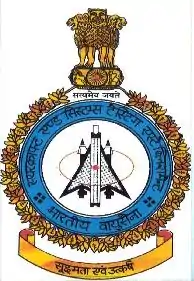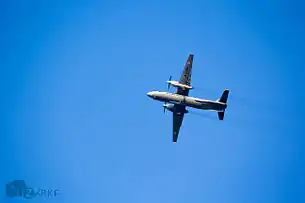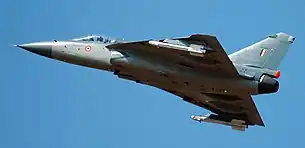| Indian Air Force Test Pilot School | |
|---|---|
 | |
| Active | April 1957 – present |
| Country | India |
| Branch | Indian Air Force |
| Type | test pilot school |
| Role | Training of test pilots and flight test engineers |
| Part of | Aircraft & Systems Testing Establishment (ASTE) |
| Garrison/HQ | Hindustan Aeronautics Limited Bangalore |
| Nickname(s) | (AFTPS) Air Force Test Pilots School |
| Motto(s) | Sukshamata Evam Utkarsh |
| Decorations | Award of Presidential Standard |
The Indian Air Force Test Pilot School is a unit of the Indian Air Force (IAF) that evaluates aircraft and systems for induction into user organisations. Most new aircraft types and major airborne systems must have ASTE's stamp of approval to be considered fit for service in India. While many countries have testing facilities of one kind or the other, training of flight test personnel is not often imparted in them. ASTE's Air Force Test Pilots School (AFTPS) is only the fifth such institution in the world.[1]

History
Since India's independence, the IAF has been actively involved in defending territorial boundaries. In 1948, the IAF acquired its first jet fighter type, the de Havilland Vampire, and the Aircraft Testing Unit (ATU) was raised under the command of Wg Cdr H Moolgavkar to accept and test these aircraft. By the early 1950s, IAF felt the need to expand its aircraft holdings. The ageing fleet of Vampires, Toofanis and Mysteres were required to be upgraded and eventually replaced, to meet fresh challenges. Indian aviation industry, in the form of Hindustan Aeronautics Limited (HAL), was already being provided highly skilled pilots by IAF for flight test duties. Anticipating the need for an indigenous flight-testing capability, and to launch flight testing in India on a formal footing, IAF sent two pilots to the Empire Test Pilots' School in October 1949. These pilots were followed by several others in succeeding years and they formed the core group in the establishment of the Aircraft and Armament Testing Unit (A&ATU) Kanpur, a precursor to ASTE.
On 9 December 1970, keeping pace with its expanding field of activity, the Commanding Officer's post at A&ATU was further upgraded to Group Captain, and Group Captain Kapil Bhargava VM was appointed to fill this prestigious slot. The next two years saw an increase in avionics systems trials like IFF, V/UHF sets, gun sights, FR cameras etc., in addition to armament and airframe testing. The unit's role was growing and on 23 August 1972, A&ATU was reorganised as Aircraft and Systems Testing Establishment (ASTE).[2]
In 1984, two officers of ASTE, Wg Cdr Ravish Malhotra and Sqn Ldr Rakesh Sharma achieved celebrity status, when they were selected to undergo training for the Indo-Soviet joint space venture. On 3 Apr 1984, Sqn Ldr Rakesh Sharma was launched into space in a SOYUZ T −11 along with his Soviet counterparts.[3]
His Excellency Dr A. P. J. Abdul Kalam, the President of India, presented the 'Presidential Standard' to ASTE on 21 Nov 2005.[4]
Flight evaluations

Indian Air Force test pilots, along with a Flight Test Engineer, were killed when the second prototype Saras aircraft crashed and caught fire in an open field near Bangalore. A court of inquiry found that wrong engine relight drills given to the pilots caused the crash.[5]
The year 1957 brought further challenges to A&ATU in the form of Gnat evaluation. Gnat aircraft had not yet been fully evaluated in UK when the task of evaluating this compact fighter for tropical conditions was assigned to A&ATU.
A&ATU geared up to meet this new task by setting up various sections and Flight test instrumentation laboratories. Within next three months, many test-handling sorties were flown and a detailed report – the first of many full-fledged reports generated by the unit was submitted to the Government.
After the Gnat evaluation, the unit was busy with trials on Vampire, Mystere and Hunter aircraft. In 1961, a team from Boscombe Down UK, arrived for tropical trials on the Saunders Roe P-53C Scout helicopter, giving A&ATU its first exposure to rotary wing testing. Trials on a de Havilland Canada Otter soon followed, adding transport flying expertise to the repertoire. The next major evaluation for A&ATU came up in 1964. Hindustan Aeronautics Limited, Bangalore had developed the first indigenous fighter aircraft HF-24 Marut, which was to be evaluated. In 1964, A&ATU also carried out trials on Krishak aircraft.
The late 1960s were productive years for the indigenous aviation industry. A&ATU was tasked with preview and evaluation trials for HJT-16 Hindustan Jet Trainer (Kiran), Indian variants of Alouette helicopter, Chetak and Cheetah, and Marut developmental test programme. In addition, the unit carried out trials on HS748 (AVRO) medium transport aircraft, which was thereafter inducted into IAF.
Jaguar aircraft were inducted into IAF in 1980. Along with it came technology transfer and a licence for manufacture in India. HAL and ASTE once more became the centre stage for developmental trials on advanced avionics, low-end electronic systems like the radio altimeter, VHF communication sets and other instruments.
During November 1980, Air Commodore P Singh, the Commandant of ASTE, led an IAF delegation to France for evaluation of Mirage 2000. In the next year Air Cmde P Singh led yet another delegation to the USSR for evaluation and acquisition of MiG-27 and MiG-23 aircraft. In the same year, Wg Cdr P Rajkumar, Wg Cdr Parab and Fit Lt AMS Kahlon completed flight evaluation of the An-32. This aircraft was to become the backbone of IAF's tactical transport operations from then on.[6]
Crest
The ASTE crest shows a futuristic aircraft carrying guided weapons ringed by an ellipse. A slide-rule is superimposed on the fuselage of the aircraft The slide-rule portrays precision and accuracy needed during flight-testing. It also signifies the aspects of technical knowledge and training involved in producing test pilots and test engineers. The missiles represent armament that forms the major preoccupation of ASTE as a defence services establishment. The ring portrays significant aspects of the role of ASTE. First of all, it depicts the sighting ring of a gun sight, which symbolises not only the involvement of ASTE with armament, but also its concern for constant vigil on correct aims and objectives. Secondly, it symbolises the aiming circles provided on the ground targets as seen from the air and signifies the need for accuracy of results to be obtained during flight testing. The crest also symbolises the aspirations and ambitions of ASTE in involving itself with the country's future plans in the realm of aerospace, The words 'Aircraft and Systems Testing Establishment' and 'Indian Air Force' are inscribed on the roundel in a light blue background. The 'Ashok Stambh' heads the crest and laurel leaves surround the crest. The motto printed on the crest "Sukshamta Avum Utkarsh", means "Precision and Excellence", two invariable and steadfast goals to which ASTE aims, in everything it does.[7]
Commandants
| Sl.No. | Name | Period |
|---|---|---|
| 01 | Sqn Ldr Bhopinder Singh | Jun 57 to Nov 59 |
| 02 | Sqn Ldr Suranjan Das | Nov 59 to Jun 61 |
| 03 | Wg Cdr JJ Bouche | Jun 61 to Jan 64 |
| 04 | Wg Cdr BK Ghosh | Jan 64 to Jun 68 |
| 05 | Wg Cdr Karan Yadav | Jun 68 to Dec 69 |
| 06 | Wg Cdr/ Gp Capt Kapil Bhargava VM | Jan 70 to Dec 72 |
| 07 | Gp Capt/ Air Cmde CV Gole PVSM AVSM | Dec 72 to Aug 74 |
| 08 | Gp Capt/ Air Cmde RD Sahni | Aug 74 to Dec 77 |
| 09 | Air Cmde PK Dey AVSM | Jan 78 to Jul 79 |
| 10 | Air Cmde P Singh AVSM VM & Bar | Jul 79 to Sep 82 |
| 11 | Air Cmde Palamadai Muthuswamy Ramachandran AVSM SC VM | Oct 82 to Dec 84 |
| 12 | AVM PK Dey AVSM | Jan 85 to Jul 86 |
| 13 | Air Cmde/ AVM AS Lamba Vr C | Aug 86 to Apr 91 |
| 14 | Air Cmde P Rajkumar AVSM VM | May 91 to Jul 93 |
| 15 | Air Cmde SC Rastogi VSM | Jul 93 to Jan 96 |
| 16 | Air Cmde AK Thakur | Jan 96 to Dec 96 |
| 17 | Air Cmde P Mehra VM | Jan 97 to Jan 99 |
| 18 | Air Cmde Parvez Khokar VM | Jan 99 to Jan 01 |
| 19 | Air Cmde AK Nagalia VM VSM | Jan 01 to Mar 02 |
| 20 | Air Cmde Anil Chopra VM VSM | Mar 02 to Dec 04 |
| 21 | Air Cmde PR Sharma | Dec 04 to Dec 06 |
| 22 | Air Cmde M Matheswaran VM | Dec 06 to May 8 |
| 23 | Air Cmde Jose Mathappan VSM | May 8 to Dec 10 |
| 24 | Air Cmde BR Krishna, SC | Dec 10 to Dec 11 |
| 25 | AVM R Nambiar VM & Bar | Dec 11 to 2014 |
| 26 | AVM Rajeev Hora | 2014 to Nov 2016 |
| 27 | AVM Sandeep Singh | Nov 2016 to Dec 2018 |
| 28 | AVM Shridher Kishore Mohlah | Jan 2019 to May 2020 |
| 29 | AVM Jeetendra Mishra VSM | Jun 2020 to Dec 2022 |
| 30 | AVM Tejpal Singh | Jan 2023 to Present |
See also
Notes
- ↑ (Retd), Gp Capt Kapil Bhargava. "Air Force Test Pilots School". Archived from the original on 9 June 2011. Retrieved 16 September 2018.
- ↑ History. Indian Air Force. Retrieved 4 March 2011.
- ↑ The Space Odyssey. Indian Air Force. Retrieved 4 March 2011.
- ↑ Award of Presidential Standard. Indian Air Force. Retrieved 4 March 2011.
- ↑ "3 pilots dead in aircraft crash near Bangalore". The Times of India. Archived from the original on 5 November 2012. Retrieved 16 September 2018.
- ↑ Flight Evaluations. Indian Air Force. Retrieved 4 March 2011.
- ↑ Crest. Indian Air Force. Retrieved 4 March 2011.
- ↑ Commandants. Indian Air Force.